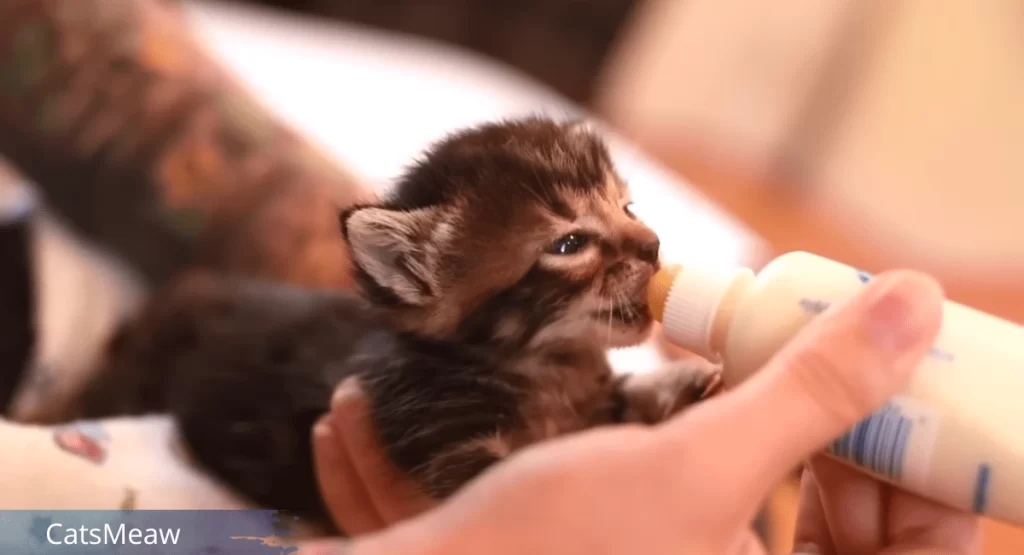Caring for a newborn kitten can be a rewarding experience, but it comes with its challenges, especially when it comes to feeding. Bottle feeding a kitten is a crucial skill that ensures they receive the necessary nutrients for healthy growth. Whether you’re fostering an orphaned kitten or providing extra care to a young one, knowing the right steps can make all the difference.
In this guide, we will walk you through the essential steps you need to know to successfully bottle feed a kitten, ensuring they thrive and grow strong.

Best Guide For Bottle Feeding a Kitten
Table of Contents
Step One: Buy Formula
It’s the first thing to do. And for good reason, formula milk is the only milk suitable bottle feeding a kitten (apart from their mother’s milk, of course). There is no question of giving them cow’s milk, or even goat’s milk or any other milk! Without formula milk, it will be difficult for them to survive the first weeks of life. In fact, it is only at the age of two or even three months that a kitten can definitively exclude milk from its diet, after the weaning period.
To get one, it’s very simple, go to a veterinary clinic, pet store, pharmacy, or even sometimes a supermarket.
Good to know: in case of emergency, and if you don’t have kitten formula nearby, you can prepare a homemade recipe for bottle feeding a kitten: mix 100 ml of goat’s milk with 100 ml of crème fraîche with 12% content fat and 1 egg yolk. Like that of the cat, the milk must be low in lactose, rich in protein and fat.
Second step: choosing the bottle
Generally, Nursing Bottle are provided with the formula. So you won’t have to worry about it. On the other hand, don’t dare choose a bottle for a human baby for bottle feeding a kitten, the teat would be much too big for your little kitten. Be sure to only use bottles intended for kittens.
Third step: preparing the bottle
Do not hesitate to scrupulously follow the instructions on the box of kitten formula. For example, the water in the bottle must be lukewarm (37-38°C) before adding the milk powder. However, be careful that it is not too cold or too hot. In fact, this could cause diarrhea in your kitten. However, this can be fatal at this age.
Likewise, the bottle must be washed carefully after each meal to avoid the development of bacteria. And above all, don’t forget to wash your hands before handling the milk and the bottle!
Fourth step: taking the bottle itself
Before Bottle Feeding a Kitten, Sit comfortably, preferably in a quiet place. Take the kitten in your hand, positioning it in front of you, as seated as possible. Bring the bottle to its mouth and squeeze out a few drops of milk. Then, gently insert the pacifier into its mouth and let it drink quietly.
Related: New Kitten Checklist: Best Essentials for your Feline
Be careful never to feed a kitten on its back! In fact, it could go the wrong way, which can be very dangerous at this age.
Fifth step: the dosages to respect
A kitten that has just been born will not have the same milk needs as a kitten that is several weeks old. You will therefore need to strictly follow the dosages indicated on the box of milk or communicated by your veterinarian for a healthy bottle feeding a kitten.
Generally, they are on this order:
First week of life: 8 meals per day
Second week: 6 meals per day
Third week: 5 meals per day; the kitten is able to lap up milk.
Fourth week: 4 meals per day; the kitten begins to eat solid food.
Good to know: a properly fed kitten generally gains 100 grams per week.
Last step: stimulating the kittens
A cat not only feeds its kittens, it also plays an essential hygienic role. In fact, it is who must help them relieve themselves by licking their bellies and genital areas.
So don’t panic, you won’t have to use your tongue. On the other hand, you will need, after each bottle feeding a kitten, to massage your kitten’s perineal area using a damp glove. The objective? Help them pass their stools and urine. It’s not the most pleasant, we grant you, but it is indeed an essential step!
